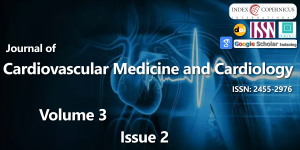A Case of Balloon Rupture Cause Serious Complication during Percutaneous Coronary Intervention
Main Article Content
Abstract
Balloon rupture in the process of percutaneous coronary intervention (PCI) leading to coronary artery dissection, subintimal hematoma and hematoma extension after stent implantation is an uncommon complication, but it has important clinical significance. The reason for balloon rupture during PCI and hematoma extension after stent implantation is not clear. In this case, Balloon rupture may be due to excessive balloon dilation pressure, severe coronary artery calcification, balloon dilatation with gas presence and poor quality of the balloon; hematoma extension after stent implantation may be for remaining undiscovered hematoma and dissection. We should pay attention to these risk factors and prevent the occurrence of clinical complications in the treatment of PCI.
Downloads
Article Details
Copyright (c) 2016 Li J, et al.

This work is licensed under a Creative Commons Attribution 4.0 International License.
Katayama T, Sakoda N, Yamamoto F, Ishizaki M, Iwasaki Y (2010) Balloon rupture during coronary angioplasty causing dissection and intramural hematoma of the coronary artery; a case report. J Cardiol Cases 1: 17-20. Link: https://goo.gl/Mg6R4P
Rothschild R, Voda J (1990) Coronary artery dissection caused by angioplasty balloon rupture. Cathet Cardiovasc Diagn 19: 26-29. Link: https://goo.gl/7OKmMK
Pedersen WR, Goldenberg IF, Johnson RK, Mooney MR (2003) Successful rotational atherectomy in the setting of extensive coronary dissection: a case of failed balloon angioplasty in a nondilatable calcified lesion complicated by balloon rupture and extensive dissection. Catheter Cardiovasc Interv 59: 329–332. Link: https://goo.gl/gU3UXo
Alfonso F, Pérez-Vizcayno MJ, Hernández R, Goicolea J, Fernández-Ortíz A, et al. (1997)Clinical and angiographic implications of balloon rupture during coronary stenting. Am J Cardiol 80: 1077-1080. Link: https://goo.gl/omtjFX
Maehara A, Mintz GS, Bui AB, Castagna MT, Walter OR, et al. (2002) Incidence, morphology, angiographic findings,and outcomes of intramural hematomas afterpercutaneous coronary interventions: an intravascular ultrasound study. Circulation 105: 2037-42. Link: https://goo.gl/CrLmsp
Shirodaria C, Van Gaal WJ, Banning AP (2007) A bleeding kiss: intramural haematoma secondary to balloon angioplasty. Cardiovasc Ultrasound 5: 21. Link: https://goo.gl/L0WiB5
LeMay MR, Beanlands DS (1990)Pinhole balloon rupture during coronary angioplasty causing rupture of the coronary artery. Cathet Cardiovasc Diagn 19: 91-92. Link: https://goo.gl/ztveNV
Esente P, Giambartolemei A, Reger MJ, Walford G, Johnson LW (1996) Extensive coronary dissection caused by balloon rupture at high pressure during stent deployment. Cathet Cardiovasc Diagn 38: 263-265. Link: https://goo.gl/vHyiDY
Abdou SM, Wu, CJ(2011)Treatment of aortocoronary dissection complicating anomalous origin right coronary arteryand chronic total intervention with intravascular ultrasound guided stenting. Catheter Cardiovasc Interv 78: 914-919. Link: https://goo.gl/gEuBJ2





